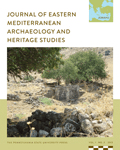
Journal of Eastern Mediterranean Archaeology and Heritage Studies
Scope & Guideline
Advancing Archaeological Insights in a Timeless Region
Introduction
Aims and Scopes
- Interdisciplinary Archaeological Research:
The journal emphasizes the integration of various methodologies, including fieldwork, archival research, and data modeling, to enrich archaeological understanding and heritage studies. - Cultural Heritage and Preservation:
A core focus is on the assessment, preservation, and community involvement in cultural heritage, particularly in conflict-affected areas, highlighting the importance of local narratives and voices. - Postcolonial Perspectives in Archaeology:
The journal frequently addresses themes of nationalism, colonialism, and decolonization, aiming to critically analyze the impact of historical narratives on contemporary archaeological practices. - Socio-Economic Dynamics in Ancient Societies:
Research articles explore the socio-economic structures of ancient civilizations, including trade networks, agricultural practices, and community interactions, to provide insights into their complexities. - Material Culture and Identity:
The journal investigates how material culture, including artifacts and architecture, reflects and shapes identities, religious practices, and social dynamics in the Eastern Mediterranean.
Trending and Emerging
- Decolonization in Archaeology:
Recent publications increasingly focus on decolonizing methodologies and practices within archaeology, emphasizing the need to reassess historical narratives and engage with local communities in the preservation of heritage. - Community-Led Heritage Initiatives:
There is a growing trend towards exploring community involvement in heritage management and archaeological practices, showcasing how local voices contribute to the understanding and preservation of cultural heritage. - Digital and Quantitative Methods:
The incorporation of digital techniques and data modeling in archaeological research is on the rise, allowing for innovative analyses of ancient societies and their interactions, as well as enhancing the accessibility of archaeological data. - Cultural Identity and Materiality:
Emerging themes focus on the relationship between material culture and identity formation, particularly in the context of ancient Mediterranean societies, reflecting a deeper exploration of how artifacts inform our understanding of social dynamics. - Environmental Archaeology and Sustainability:
Recent studies are increasingly addressing the interactions between ancient societies and their environments, emphasizing sustainable practices and agricultural innovations, which are relevant to contemporary discussions on climate change and resource management.
Declining or Waning
- Traditional Historical Narratives:
There is a noticeable decrease in papers focusing solely on traditional narratives of ancient history without integrating contemporary methodologies or critical perspectives, indicating a shift towards more dynamic and multi-faceted approaches. - Eurocentric Perspectives:
Research that centers predominantly on Eurocentric views of the Eastern Mediterranean is declining, as the journal increasingly prioritizes local narratives and postcolonial critiques that challenge traditional historiography. - General Overviews of Ancient Cultures:
The journal has moved away from broad overviews of ancient cultures in favor of more focused studies that delve into specific archaeological findings or theoretical frameworks, suggesting a preference for depth over breadth. - Descriptive Archaeological Studies:
Papers that primarily describe archaeological sites without engaging in broader theoretical discussions or interdisciplinary approaches have become less common, reflecting a trend towards more analytical and integrative research.
Similar Journals
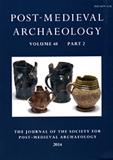
Post-Medieval Archaeology
Connecting Artifacts to Historical NarrativesPost-Medieval Archaeology is a distinguished academic journal published by ROUTLEDGE JOURNALS, TAYLOR & FRANCIS LTD, focusing on the rich tapestry of human history from the post-medieval period through the lens of archaeology. With a proud publication history spanning since 1967, this journal addresses the integration of archaeological findings with historical narratives, contributing significantly to the field of archaeology and history. The journal holds an impressive categorization within the Q2 and Q3 quartiles for Archaeology and History in 2023, showcasing its commitment to academic excellence and relevance within these disciplines. Researchers and professionals alike will find value in its critical examinations and innovative methodologies that illuminate the past, making it a pivotal resource for those engaged in archaeological research. As an essential platform for scholarly debate and dissemination, Post-Medieval Archaeology continues to advance the understanding of post-medieval contexts and material culture, fostering discussions that resonate through various areas of the arts, humanities, and social sciences.
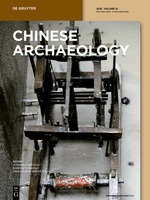
Chinese Archaeology
Advancing Insights into Ancient CivilizationsChinese Archaeology, published by WALTER DE GRUYTER GMBH, is a leading journal dedicated to the exploration and study of China's rich archaeological heritage. With an ISSN of 2160-5025 and an E-ISSN of 2160-5068, this journal serves as an essential platform for scholars, researchers, and enthusiasts in the field of archaeology, offering a blend of original research articles, reviews, and critical essays that address both contemporary issues and historical narratives. While it currently operates under a conventional access model, making cutting-edge research available to a select audience, it plays a crucial role in advancing knowledge about China's archaeological sites, artifacts, and past civilizations. Given the increasing interest in Eastern archaeology and its significance in a global context, Chinese Archaeology is positioned as a pivotal resource for understanding and interpreting the complexities of China’s historical evolution. Researchers and academics are encouraged to contribute and engage with this vital field of study to foster greater insights and innovations.

Spal
Bridging Time: Where Archaeology Meets History.Spal is a distinguished academic journal dedicated to the fields of Archaeology and History, published by the University of Seville, Editorial. With an ISSN of 1133-4525 and an E-ISSN of 2255-3924, it has established a prominent reputation within the scholarly community, currently enjoying an impressive Q1 ranking in Archeology (Arts and Humanities) and History, alongside a Q2 ranking in Archeology for 2023. The journal serves as a critical platform for researchers, professionals, and students alike, promoting the dissemination of cutting-edge research and innovative methodologies in these vital disciplines. Spal's Scopus Ranks place it in the 84th percentile for Arts and Humanities - History and the 72nd for Archeology within the field, emphasizing its impact and relevance in contemporary scholarship. Although it operates under a traditional access model, its commitment to advancing knowledge and discourse in archaeological and historical studies remains unwavering. The journal's coverage spans from 2015 to 2024, positioning it well to contribute to ongoing academic conversations and foster collaborations within the global research community.

Revista de Arqueologia Historica Argentina y Latinoamericana
Fostering Interdisciplinary Dialogues in Archaeological ScholarshipRevista de Arqueologia Historica Argentina y Latinoamericana is a vital scholarly journal dedicated to the field of archaeology, with a particular focus on the historical dimensions of Argentina and Latin America. Published by the Assoc Professional Archaeologists Argentine Republic, this open-access journal has been enriching the archaeological discourse since 2007, making its valuable content freely accessible to researchers, professionals, and students around the globe. With an ISSN of 1851-3190 and an E-ISSN of 2344-9918, the journal aims to foster a deeper understanding of the archaeological heritage of the region by publishing innovative research articles, critical reviews, and methodological advancements in the study of historical archaeology. Positioned as a prominent platform for scholarship, it plays a crucial role in advancing archaeological knowledge while promoting interdisciplinary approaches within the field.

Archaeologia Maritima Mediterranea-An International Journal on Underwater Archaeology
Diving Deep into Maritime HeritageArchaeologia Maritima Mediterranea is a prestigious international journal focused on the vital field of underwater archaeology, published by FABRIZIO SERRA EDITORE. With an ISSN of 1724-6091 and E-ISSN 1825-3881, this journal has been a cornerstone for scholars and enthusiasts alike in the study of maritime cultures, shipwrecks, and submerged sites around the Mediterranean region since its inception. Operating from its base in Pisa, Italy, the journal has a commendable academic presence, reflected in its recent Scopus rankings which place it in the lower quartiles in both Arts and Humanities, and Social Sciences subcategories within archaeology. Despite its current Q4 categorization, it serves as an important platform for emerging research and advancements in the field, aiming to foster collaboration and knowledge exchange amongst researchers, practitioners, and students. While the journal is accessible through traditional subscription models, the lack of open access emphasizes the publisher's commitment to maintaining high academic standards. The collection of issues from 2011 to 2023 showcases a rich tapestry of research that contributes significantly to our understanding of underwater cultural heritage.
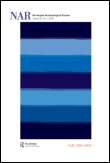
Norwegian Archaeological Review
Exploring the Past, Illuminating the FutureNorwegian Archaeological Review, published by Routledge Journals, Taylor & Francis Ltd, is a leading interdisciplinary journal that has made significant contributions to the field of archaeology since its inception in 1968. With an impressive Q1 ranking in the Arts and Humanities category for archaeology and an 86th percentile ranking in Scopus, this journal serves as a crucial platform for showcasing innovative research that advances our understanding of human history and cultural heritage. The Review provides a diverse range of scholarly articles, critical reviews, and thoughtful discussions, making it an essential resource for researchers, professionals, and students alike. While the journal currently does not offer an open-access option, it continues to maintain high editorial standards and relevance within the academic community, with publication converging up to 2024. The Norwegian Archaeological Review thrives as a nexus for academic discourse, encouraging the exploration of archaeological methodology, theory, and practice against the backdrop of contemporary global challenges.
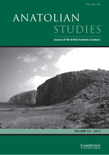
Anatolian Studies
Exploring the Depths of Anatolian HeritageAnatolian Studies, published by Cambridge University Press, stands as a premier forum for research in the fields of archaeology, cultural studies, and history. Established in 1951, this esteemed journal has consistently contributed to the academic discourse surrounding the rich and multifaceted history of Anatolia, earning its place in the Q1 category across multiple disciplines. With a notable impact factor reflected in its Scopus rankings, it ranks among the top journals in its fields: 78th in History, 155th in Cultural Studies, and 55th in Archaeology, showcasing its significant influence and recognition. This journal serves as an invaluable resource for researchers and scholars seeking to delve into the intricacies of Anatolian heritage, providing a platform for innovative research and critical discussion within the academic community. While it currently does not offer open access, Anatolian Studies continues to enrich scholarly resources and advance knowledge within its key areas of focus.

Egyptian Journal of Archaeological and Restoration Studies
Exploring the Depths of Archaeological Innovation.Welcome to the Egyptian Journal of Archaeological and Restoration Studies, a vital resource for scholars and practitioners in the field of archaeology and restoration. Published by the renowned SOHAG UNIV PUBLICATION CENTER-SUPC, this journal aims to disseminate cutting-edge research that illuminates the rich archaeological heritage of Egypt and beyond. With ISSN 2090-4932 and E-ISSN 2090-4940, this journal showcases innovative methodologies and interdisciplinary approaches, significantly contributing to our understanding of cultural heritage preservation. The journal's growing influence is reflected in its Q3 ranking in multiple categories, including Archaeology, Conservation, and Cultural Studies as of 2023, alongside its noteworthy placement within the Social Sciences. Open access options provide wider accessibility to essential studies, making it an indispensable tool for researchers, professionals, and students alike. Join us in exploring the past and shaping the future of archaeological scholarship.
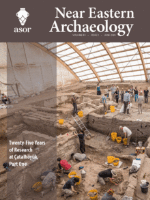
NEAR EASTERN ARCHAEOLOGY
Connecting Scholars to the Heart of Archaeological ResearchNEAR EASTERN ARCHAEOLOGY, published by University of Chicago Press, is a premier journal dedicated to the field of archaeology, particularly focusing on the rich cultural heritage and archaeological findings of the Near East. With an ISSN of 1094-2076 and an E-ISSN of 2325-5404, this esteemed publication provides a vital platform for scholars and practitioners to share their research, insights, and discoveries. The journal holds an impressive ranking in the Q1 quartile for both Archaeology and History in 2023, reflecting its significant impact within these fields and a robust history of scholarly contribution. The journal has been pivotal in shaping discussions around archaeological methodology, theory, and contemporary issues from 2002 to 2024, as it continues to reach a wide audience through various access options. With Scopus rankings placing it in the top percentiles for both History and Archaeology, NEAR EASTERN ARCHAEOLOGY represents an essential resource for researchers, professionals, and students alike, fostering the exploration and understanding of the region's archaeological narrative.

Journal of Ancient History and Archaeology
Unveiling the Secrets of Our PastJournal of Ancient History and Archaeology is a premier, open-access academic journal published by MEGA PUBLISHING HOUSE since 2014, dedicated to exploring the rich tapestry of ancient civilizations and archaeological discoveries. With ISSN 2360-266X, this journal has made significant strides in the field, achieving elevated rankings across multiple categories, including Q1 in Classics and Q2 in History as of 2023. Positioned in Romania, the journal serves an international audience of researchers, professionals, and students who seek to disseminate and access influential scholarship in ancient history and archaeology. As a prominent resource within the Scopus rankings, it reflects a robust commitment to advancing knowledge through quality research, making it a vital platform for the sharing and discussion of innovative ideas and methodologies. The journal covers a wide array of topics related to ancient societies, enhancing our understanding of their cultural, historical, and archaeological significance.